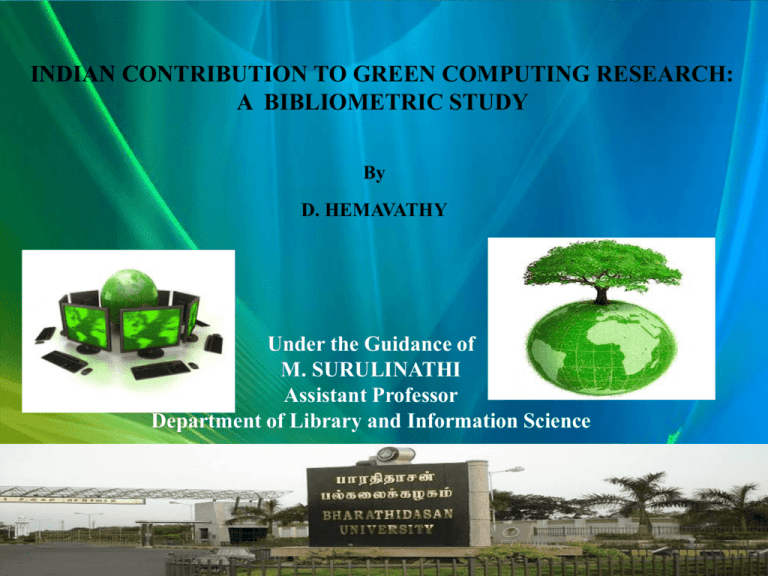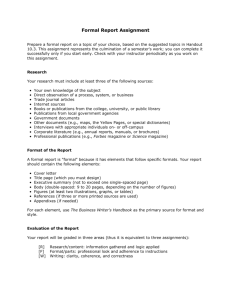Hemavathy
advertisement

INDIAN CONTRIBUTION TO GREEN COMPUTING RESEARCH: A BIBLIOMETRIC STUDY By D. HEMAVATHY Under the Guidance of M. SURULINATHI Assistant Professor Department of Library and Information Science Here comes your footer Page 1 INTRODUCTION Computing technology plays a more and more important role in our day to day Life. Subsequently the associated high volume of energy consumption has become a major concern both economically and environmentally. Green computing is emerging as an inspiring solution, which is developing computing technologies that can effectively reduce energy consumption which leads to significant CO2 emission reduction. “Green computing is to use computers and related resources in environment friendly ways”. It takes a lot of energy to create, package, store, and move every 10-20 megabytes of data. Even with energy prices as cheap as they are now, it will soon cost more to power a computer for four years than it does to buy a new one. Green computing has recently been advocated in literature to reduce energy consumption in computer systems. For example, in a mobile and embedded wireless network system, energy efficiency rather than the network throughput becomes the major concern. Green computing practices were primarily introduced by the Environmental Protection Agency in 1992 with the launch of the Energy Star program. STATEMENT OF THE PROBLEM As an emerging topic in IT management, “Green IT” practices are drawing high interest among IT organizations as well as suppliers, manufacturers and service providers. By keeping this view in mind, the researcher intends to undertake the study on “Indian Contribution to Green Computing: A Bibliometric Study”. This study attempts to analyses the performance of Indian researcher working in the field of Green Computing in terms of, research concentration, authorship pattern, scattering of articles in different sources, Institution wise distribution and so on. OBJECTIVES OF THE STUDY The major objectives are framed with the exclusive notion of the present study as mentioned below: To examine the growth of research productivity of Green Computing during 1968- 2012. To identify the Bibliographic form-wise distribution of publications in Green Computing in India. To study the subject-wise breakup of publications. To determine the authorship pattern and determine the degree of collaboration in Green Computing research. To identify the country-wise collaboration research of publications. To assess the Institution wise research concentration of Green Computing in India METHODOLOGY The data was collected from Engineeringvillage2 database during the period 1968-2012. It can be seen that nearly 596 bibliographic records of contribution in field of Green Computing over the period of 45 years. The researcher applied the search strings “Green Computing” is used for the data extraction from the database of INSPEC, COMPENDEX and GEOBASE (totally forty five years) download the records based on the above strings. A total of 596 records were downloaded and analyzed as per the objectives of the study. This research study explores to examine the growth rate during the study period. The study aims to analyze the thrust areas of research concentration on Green Computing research in India. It is also analytical in nature with the suitable statistical tools applications in strengthening the empirical validity. Year wise distribution of publications The table could clearly see that during the period 1968 - 2012 a total of 596 publications were published. The highest publication is 80 in 2011 followed by 55 papers in 2010 and 54 papers in 2008. The lowest publication is 1 in 1968 and 1969. Table 1 shows that year wise distribution of Publications Year Publications 2012 2011 2010 2009 2008 2007 2006 2005 2004 2003 2002 2001 2000 1999 1998 1997 1996 1995 1994 1993 1992 1991 34 80 55 49 54 30 27 24 25 18 19 7 15 17 11 5 8 9 5 3 7 1 % 5.88 13.84 9.51 8.47 9.34 5.19 4.67 4.15 4.32 3.11 3.28 1.21 2.60 2.95 1.90 0.87 1.38 1.56 0.87 0.52 1.21 0.17 Year 1990 1989 1988 1987 1986 1985 1984 1983 1982 1981 1980 1979 1978 1977 1976 1975 1974 1973 1972 1970 1969 1968 Publications 8 4 1 11 7 5 6 1 2 5 5 5 5 6 6 1 2 3 4 4 1 1 % 1.38 0.69 0.17 1.90 1.21 0.87 1.04 0.17 0.35 0.87 0.87 0.87 0.87 1.04 1.04 0.17 0.35 0.52 0.69 0.69 0.17 0.17 Database wise distribution of Publications The Study reveals that the major databases covered by Engineering Village2 on green computing reach in COMPENDEX 288 (48.32%), while, INSPEC Comprises in 271 (45.50%) and Article in GEOBASE 37 (6.40%). Table 2 shows that database wise distribution of Publications % Database Publications COMPENDEX 288 INSPEC 271 GEOBASE Total 37 596 48.32 45.47 6.21 100.00 Document wise distribution of Publications The study reveals that the major source of publications covered by Engineeringvillage2 on Green computing research in journal articles 455 (76%), while conference articles comprises 138(24%) comprises Monograph and Article in Press 2(0.34%) and chapter 1(0.17) of the remaining literature. Document type Publications Journal article 455 Conference article 138 Article in Press 2 Monograph chapter 1 Total 596 % 76.34 23.81 0.34 0.17 100.00 Table 4 shows that Ranking of Authors Table 4 indicates ranking of authors by number of publications. Authors “Gupta, R. K.” published highest number of 18 publications, Next authors Kumar, R. published next highest number of 16 publications, Sen, Debabrata published highest 13, Sharma, J. N.published highest number 12 publications, Buddhudu, S. highest number of 11 publications and followed by others. Author Publications Gupta, R. K. 18 Kumar, R. 16 Sen, Debabrata 13 Sharma, J. N. 12 Buddhudu, S. 11 Ajay 10 Haridasan, T. M. 10 Singh, A. K. 10 Kumar, Rajneesh 9 Ghosh, M. K. 8 Ghosh, M. K. 6 Country wise Collaboration Research The below table indicates that among the country wise publication of research on Green Computing covered by The study tops United States with 22, and followed by United Kingdom with 5, Germany with 3, Australia and others with 2 and 1 research respectively. publications Country United States United Kingdom Germany Australia Brazil Japan Mexico Singapore Canada Denmark Greece Iran Italy Romania Sweden Uzbekistan Publications 22 5 3 2 2 2 2 2 1 1 1 1 1 1 1 1 Institution wise distribution of Publications The below table analysis indicates Department-wise research productivity. It is noted that various institutions were contributed 596 of the total publications. It is noted that Dept. Of Phys., Univ. Of Jodhpur, Jodhpur contributed the highest number of 11 researches on green computing publications and followed by other Institution with department. Author affiliation Dept. Of Phys., Univ. Of Jodhpur, Jodhpur Department Of Applied Mathematics, University Of Calcutta Department Of Mathematics, Kurukshetra University Department Of Physics, Narasinha Dutt College Department Of Ocean Engineering And Naval Architecture, Indian Institute Of Technology Indian Inst Of Technology Dept. Of Electron. Electr. Commun. Eng., Indian Inst. Of Technol., Kharagpur Dept. Of Appl. Math., Univ. Of Calcutta, Kolkata Theor. Condensed Matter Phys. Div., Saha Inst. Of Nucl. Phys., Kolkata Dept. Of Phys., Annamalai Univ., Annamalainagar Theoretical Condensed Matter Physics Division, Saha Institute Of Nuclear Physics Department Of Mathematics, National Institute Of Technology Dept. Of Phys., Sri Venkateswara Univ., Tirupati Indian Register Of Shipping Publications 11 9 7 6 6 6 6 5 5 5 5 5 5 5 Here comes your footer Page 17 CONCLUSION The paradigm shift over the period is a gradual increase in the study period but good response is observed in the year 2008, 2010 and 2011. During 45 years period contributions in terms of number of publications is not significant. A comparison of Indian output in relation to the world output may help in understanding the contribution in a better angle. Though the records available in the Engineeringvillage2 reveal a small number, it is important that the Engineeringvillage2 covers only the Green computing Research Articles. ACKNOWLEDGEMENT I am very glad to express my sincere gratitude to Mr. M. SURULINATHI, Assistant Professor, Department of Library and Information Science, Bharathidasan University for his guidance and encouragement throughout my project. I would like to thank Dr. S. SRINIVASARAGAVAN, Librarian & Head, Department of Library & Information Science, and Bharathidasan University for his encouragement. I am very much thankful to Assistant Professors Dr. R. Balasubramani, Dr. N. Amsaveni, Mr. C. Ranganathan, Mr. B. Jeyapragash and Technical Officers B. Neelakandan, C. Kokila, P. Jayanthi and other Library staffs helping me as a resource person and providing me his valuable suggestions. Here comes your footer Page 20

